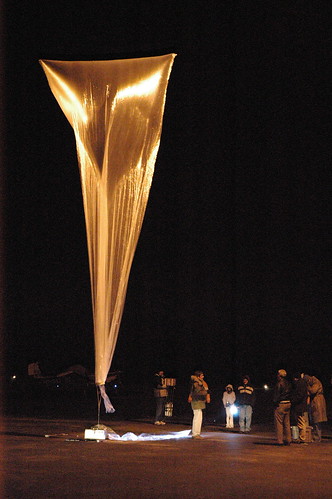Like many of you, last Thursday I was glued to the TV watching this "UFO" over Colorado with what was believed to be a kid inside the lower compartment. Thousands of feet over land, thoughts were the obvious for me: Was Falcon Heene cold? Did he have adequate oxygen at whatever altitude he was located? Was the helium mixing with the lower compartment? Was he even on board?

I was relieved when he wasn't on the balloon and then began to wonder where he was. I was out of the house shopping for clothes for a funeral when I got word he was found at home.
I've dabbled with high-altitude balloons over the last 3-4 years, most notably trying to get one across the Atlantic. I have a little bit of knowledge about helium and zero-pressure balloons like what we used for the attempts. I'd like to think I, though not the expert, had a little more than the average bear about what was going on. So when I saw the balloon in the sky with only helicopter cameras and high-def zoom for reference, I couldn't judge just how large this balloon was. It could have been 30' in diameter, 50', 100' maybe? It wasn't easy to determine.
Then, when I saw it coming down to the ground, only when I saw the rescue person chasing after it did I see how big it truly was. I gathered it to be 10-15' in diameter after using the chaser for reference (see below).

When I saw the balloon's true size, it couldn't possibly lift off the ground with a 6-yr-old, much less carry him 50 miles.
I had my doubts based on what I did with launching balloons for Spirit of Knoxville back a couple years ago. I've emptied large tanks of helium into a 1500kg latex balloon and it would have maybe 15 lbs of lift.
How, then could a 50 lb boy (rough guess) reside in a roughly 20 lb "UFO" (another rough guess) with that much helium? It didn't seem possible, at least to me.
My suspicions were validated when the balloon turned up no boy inside. Only after the drama did we see the actual launch of the balloon, and even there I was stumped at how people might think a child was in there, as flimsy as it was slowly climbing into the sky.

I am on a couple of ARHAB mailing lists, and this was a hot topic for those who are more adept at calculating lift, volume, and the specs of what size balloon would be needed for lifting large payloads (like children). However, the debate was somewhat divided, several thought the balloon might be able to lift 60+ lbs of human into the great beyond, and others (like me) felt it was not possible. Of course, I weighed in more of the stability of the craft as opposed to just lift vs load.
In the image to the right, this was SNOX II, our 2nd attempt to send a payload up and out over the Atlantic. The balloon is what's called "zero-pressure". There is an opening at the bottom to vent excess helium as the balloon climbs to a higher altitude and the balloon expands. The venting of helium balances out the lift/load ratio, and once it has reached an equilibrium, will cruise at altitude for several hours. If you look carefully, the bubble at the top of the balloon is filled with about 13 lbs of "positive lift" helium. Below it is an anchor, but the payload was just under 12 lbs, the maximum legal size payload we could use for FAR 101 exemption of balloon flight rules. I'm holding the payload and ballast to the right of the balloon, by the way...
Now, compare the bubble in the SNOX balloon to the helium that filled the "UFO" in the picture above. Even with one side of the "UFO" deflated, I'm speculating that the helium in the SNOX balloon is roughly a third the capacity of the Heene balloon. 13 X 3 = 39 lbs of positive lift. Give or take 10 lbs, is it possible the "UFO" balloon could haul a 6-year-old boy?
I am certainly not an expert mathematician. I did well in math until we started subtraction in Kindergarten, and it was downhill from there. However, even looking at my past experience I certainly think there's no way that the Heene balloon could have ever gotten off the ground.
Now, it looks more like the whole incident was an elaborate hoax by Richard Heene and his wife and kids, who were also in on it. You have to ask what kind of deranged mind would concoct such an elaborate hoax as this, but then again, I've never watched Wife Swap to see just how insane he is.
I'm not one who would do some of the things he's done, such as taking my kids tornado chasing or hurricane chasing. The closest I've come is taking my oldest (Lauren) with me to Foothills Parkway to watch an approaching thunderstorm system, and that frightened her to where I decided not to do that again anytime soon.
Who knows what Heene was thinking when he came up with this scheme. I'm just glad he's not a ham operator. Who knows what kind of trouble he would cause then...
I do think, though, a "reality show" about a balloon autonomously crossing the Atlantic would sell much better to TV execs than whatever he had going on.

